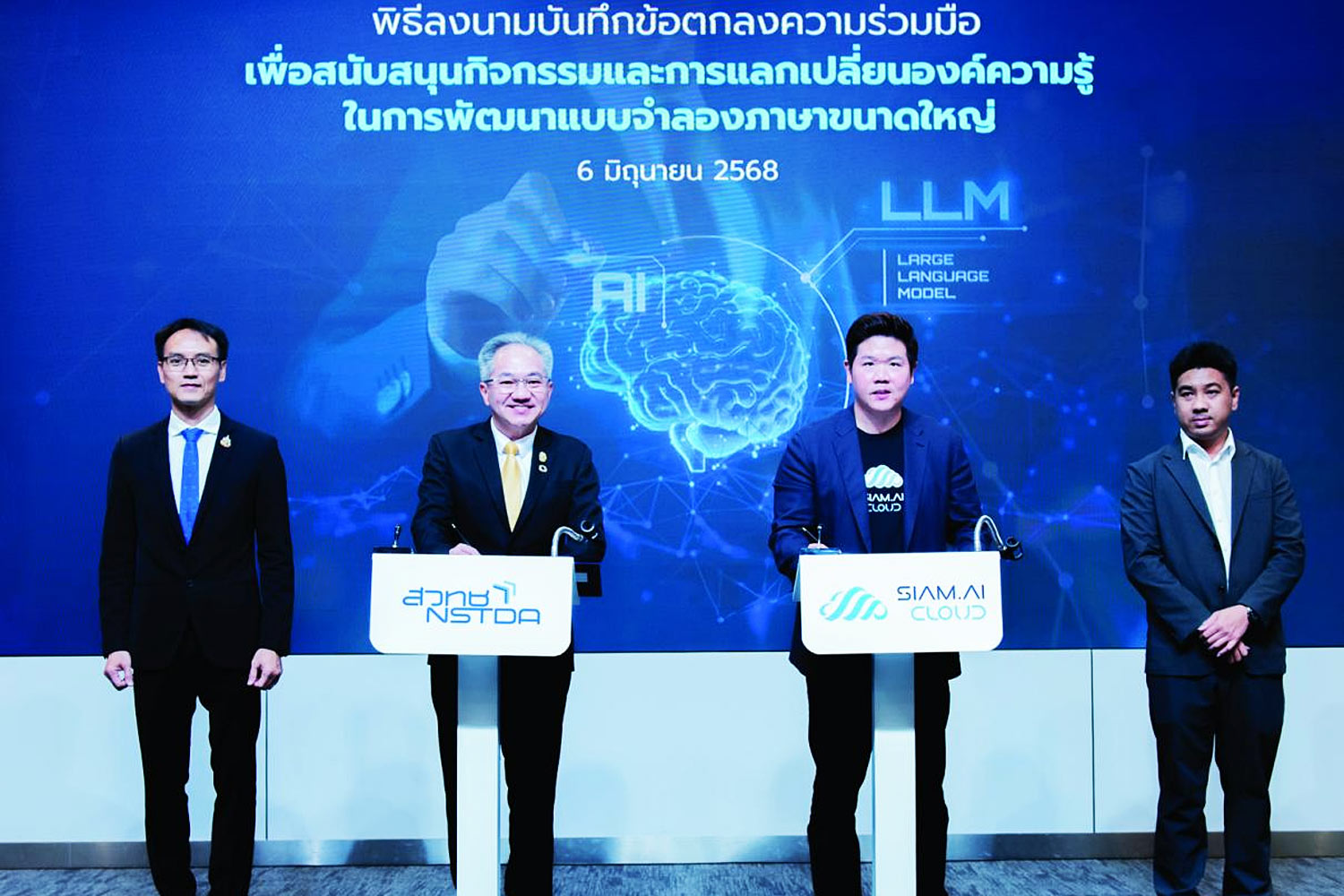NSTDA and Siam AI Forge Partnership to Build Thailand’s Native 7-Billion-Parameter Large Language Model
Thailand is advancing a sovereignty-driven AI initiative by launching a Thai-language large language model (LLM) through a strategic partnership between the National Science and Technology Development Agency (NSTDA) and Siam AI Corporation. The collaboration marks a foundational move in building Thailand’s artificial intelligence capabilities and shaping a national sovereign AI strategy that prioritizes the Thai language and local cultural context. With a substantial investment of 300 million baht from Siam AI, the project aims to establish a native Thai LLM that can understand Thai context, culture, and nuances with depth and accuracy. The collaboration was formalized through a memorandum of understanding that brings together national science and technology leadership and a private sector innovator known for its high-performance computing capabilities and AI development ambitions. This partnership signals a deliberate shift toward creating an AI ecosystem in Thailand that is not merely capable of consuming global AI advances but actively contributing to, and benefiting from, AI development rooted in Thai realities.
The leadership of NSTDA, represented by Sukit Limpijumnong, highlighted the strategic importance of a Thai LLM as a cornerstone for the country’s digital infrastructure. The emphasis is on cultivating a robust AI ecosystem that can drive innovation in digital services and enhance national competitiveness. Sukit noted that a native model would empower Thailand to solve problems and deliver services in a manner that is culturally resonant and linguistically precise, reducing reliance on foreign-developed systems and preserving valuable data within the country’s borders. He also underscored that the collaboration would support deep research and development, including the creation of a sandbox for proof of concept, and would foster the growth of a skilled workforce through sustained collaboration with Siam AI. These elements are designed to ensure that the research ecosystem remains vibrant in the long term, enabling continual advancement and refinement of Thai-language AI capabilities. In this framing, the MoU represents more than a single project; it is a deliberate commitment to building an enduring engine for AI innovation in Thailand.
Ratanaphon Wongnapachant, the chief executive of Siam AI, framed the partnership as a crucial stepping stone toward deploying a Thai LLM for commercial use across public and private organizations. He stressed the imperative of developing technology in the Thai language to avoid data leakage risk and to maintain cognitive development foundations that are specifically tailored to the country’s needs. This stance reflects a broader belief that language- and culture-specific AI systems can deliver more accurate understanding, better user experiences, and more reliable results in Thai contexts compared with imported models that may lack local nuance. Ratanaphon’s outlook centers on practical outcomes: a Thai LLM that can support decision-making, service delivery, and user interactions across sectors, while aligning with national priorities for digital modernization. The leadership of Siam AI presented the collaboration as a platform for accelerating value creation through AI, focusing on the translation of research into deployable solutions that can meet the everyday demands of Thai citizens and organizations.
The broader vision articulated by the project emphasizes foundation models or LLMs with multimodal capabilities as essential drivers of next-generation AI applications. Such models enable the integration of text, vision, audio, and sensor data to support real-time decision-making in complex environments, including autonomous systems and large-scale public service platforms. The Thai LLM project is positioned to be more than a linguistic tool; it is conceived as a foundational technology capable of absorbing diverse data modalities and delivering actionable insights that are culturally and linguistically aligned with Thailand’s administrative, commercial, and social landscapes. In that sense, the initiative is designed to lay the groundwork for AI-enabled services that can readily scale and adapt to changing needs, with an emphasis on reliability, transparency, and alignment with local governance and policy frameworks.
Siam AI outlined its infrastructure capabilities as a strategic enabler of the Thai LLM project. The company hosts one of the most advanced high-performance computing (HPC) infrastructures in Asia, featuring Nvidia Blackwell architecture and a liquid-cooled rack cluster that is specifically designed to support large-scale language models. This computing backbone is essential to training and refining Thai-language models that can handle the complexity of Thai syntax, semantics, and cultural references. The investment and capabilities described by Siam AI are presented as critical to achieving the timeline and performance targets of the project, including managing the computational demands of both model training and real-time inference in production environments. The emphasis on robust HPC infrastructure signals a commitment to ongoing experimentation, rapid iteration, and the ability to support multiple pilots and deployments as the Thai LLM matures.
Within the regional context, Thailand stands out as one of only a handful of Asian economies that has initiated the development of its own LLMs. Alongside Thailand, three other major Asian players—China, Japan, and South Korea—have either developed or been actively advancing their own language models. This positioning places Thailand in a select group of nations pursuing sovereign AI capabilities and language-specific models that can potentially transform national digital services, governance, and industry competitiveness. The Thai LLM is anticipated to reach a scale of approximately 7 billion parameters and is planned for completion within a three-month timeframe, a projection that reflects ambitious development pacing and the expectation of accelerating progress in AI research and deployment. The project builds on an earlier development phase supported by an initial funding tranche of 20–40 million baht, with the current investment expanding the scale and scope of work considerably. This continuum of funding underscores a phased approach to AI development, where early proof-of-concept milestones lay the groundwork for larger-scale implementation.
The collaboration also leverages the expertise and capabilities of other national institutions. Chai Wutiwiwatchai, executive director of the National Electronics and Computer Technology Center (Nectec), is cited as a key contributor, bringing extensive experience in multimodal LLMs to support Siam AI’s broader ambitions. Nectec has previously developed Pathumma LLM, an AI model designed to handle multimodal data—encompassing text, speech, and images—and tailored to the processing of state and public-sector documents with a strong emphasis on understanding official language, structure, and contextual nuances. This existing expertise provides a valuable foundation for the Thai LLM project, ensuring that the model can handle government-style documentation and formal discourse with high fidelity. In addition to model development, Nectec will deploy government AI projects on Siam AI’s infrastructure, which is described as scalable and flexible enough to support pilot initiatives across different government agencies. The collaboration also places emphasis on developing a skilled workforce in high-performance computing, a critical component for sustaining long-term AI capabilities and ensuring that the country can continue to advance AI research and application beyond initial milestones.
In a broader sense, the consortium’s approach to AI readiness and deployment engages several strategic elements. One priority is to position Thailand as a hub for AI-enabled services, particularly those that can export value in areas such as healthcare, governance, and digital services. The reference to global benchmarks, such as the Oxford Insights Government AI Readiness Index 2024, where Thailand placed 35th out of 188 governments, provides a framework for evaluating progress and identifying opportunities for improvement. The Thai leadership emphasizes that momentum in AI development is particularly pronounced in the medical sector, where Thailand already demonstrates deep expertise and a potential for exporting AI-driven services in the future. This perspective suggests a deliberate strategy to concentrate strengths in sectors where Thailand has established capabilities and global demand, aligning AI investment with practical and export-oriented outcomes.
As part of the evolving ecosystem, a separate but related development emerged in May, when Siam AI signed an agreement with Naver Cloud, a South Korean cloud computing and AI solutions provider. The collaboration aims to develop a Thai LLM and AI agents for the tourism sector, leveraging Naver Cloud’s experience in building and operating LLMs and its extensive Thai-language datasets. The objective is to create a Thai-specific LLM by the end of the year and to design AI agents tailored to Thailand’s high-demand tourism industry. This partnership complements the NSTDA-Siam AI collaboration by expanding the practical scope of Thai-language AI capabilities into a critical economic sector, thereby reinforcing Thailand’s strategy to anchor AI development in domestically relevant applications that can drive growth and competitiveness. The joint effort underscores the importance of multilingual data, cultural nuances, and sector-specific requirements in ensuring AI solutions that are genuinely useful to Thai users and businesses.
In summary, the NSTDA-Siam AI collaboration represents a comprehensive effort to establish Thai-language AI as a strategic asset for national development. The combination of robust financial backing, cutting-edge HPC infrastructure, and the involvement of experienced public-sector technology organizations creates a foundation for sustained research, development, and deployment. The emphasis on a native Thai LLM aligned with local culture and governance needs is intended to yield practical benefits across the public and private sectors, while also positioning Thailand to participate more actively in the regional and global AI economy. The initiative is framed as a long-term endeavor that will not only advance technical capabilities but also contribute to workforce development, policy alignment, and the responsible deployment of AI technologies within Thailand’s unique social and linguistic landscape.
Introduction of Pathumma LLM and cross-institution collaboration provides additional depth to the Thai AI landscape. The National Electronics and Computer Technology Center (Nectec) has been highlighted for its contributions to multimodal AI research and its role in supporting Siam AI’s broader mission. Pathumma LLM embodies a specialized approach to multimodal data processing, integrating text, speech, and image understanding to handle a wide array of public-sector documents and interactions with an emphasis on official language and contextual accuracy. The deployment plan for government AI projects on Siam AI’s infrastructure signals a strategic move to ensure that public-sector use cases are backed by scalable, flexible technology capable of handling the complexity and volume of state-level data flows. This emphasis on governance-ready AI aligns with Thailand’s positioning as a country investing in capabilities that can be applied across ministries and agencies while maintaining careful control over data and privacy considerations.
The public narrative also highlights the potential for export-oriented AI services, particularly in the medical domain, where Thailand already demonstrates substantial expertise. The recognition of Thailand’s momentum in AI development in this sector is presented as an opportunity to build an export-oriented AI services industry in the future. This perspective frames AI development not only as a domestic capability-building exercise but also as a pathway to international competitiveness through the provision of specialized AI solutions and services to regional and global markets. The ongoing collaboration with Naver Cloud in the tourism sector further reinforces the emphasis on sector-specific AI applications that leverage Thailand’s unique linguistic and cultural attributes, aiming to deliver value in real-world contexts while fostering sustainable growth and knowledge transfer.
Conclusion
The NSTDA-Siam AI partnership represents a consequential step in Thailand’s AI journey, combining national research leadership, private-sector investment, and international collaboration to build a native Thai LLM and a broader AI ecosystem. The initiative places linguistic and cultural specificity at the core of AI development, aiming to deliver more accurate, relevant, and trustworthy AI systems that can operate effectively within Thailand’s digital infrastructure. The investment, infrastructure, and talent development plans are designed to sustain long-term innovation and to create a virtuous cycle of research, development, and deployment that benefits both the public and private sectors. By situating this work within a broader regional context and aligning it with sector-specific applications, Thailand is positioning itself to contribute to and benefit from the next wave of AI-enabled digital transformation, while maintaining a commitment to data sovereignty and local capacity building.



